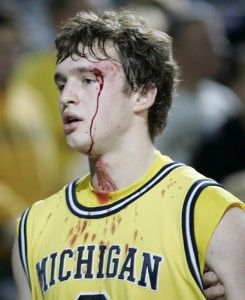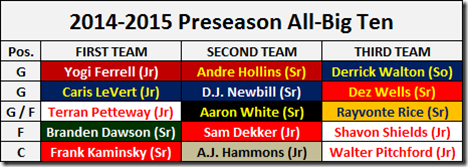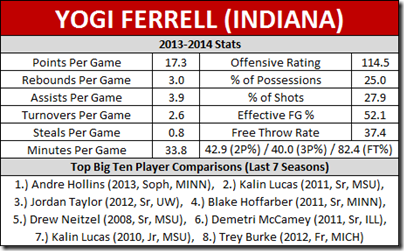basketball
As some of you know, I’m joining MGoBlog to provide various types of basketball coverage, now that we’re a #basketballschool and all that. A brief introduction: I’m an Honors LSA Senior majoring in English (hopefully with a creative writing sub-concentration), I grew up making weekly pilgrimages from the Grand Rapids area to Ann Arbor on Fall Saturdays with my parents—both of whom graduated from the B School before Ross slapped his name on it—and younger brother—an Honors LSA sophomore (who is also named Brian Cook). I am not related to the proprietor of this site, as far as he and I know. We were a football family, but I fell in love with Michigan Hoops in 2009-2010 with Manny, Peedi, Coach B, and the gang. I’ve learned to love the NBA recently as well, but regret that I missed the glory years of my Detroit Pistons. I’m a Lions masochist, I complain about the Tigers’ managing and bullpen all summer, and I recently committed to Everton as my new EPL team (because Tim Howard’s a national hero). It’s a little up in the air as of right now, but Ace and I will sort out who covers what during hoops season. As for non-sports things: I’m a proud native Michigander and spend my summers living on Barlow Lake—Heaven on Earth, as far as I’m considered—I run as quickly as Terrance Taylor and am addicted to Bruegger’s on North U (these things may be related), and if anybody wants to hire me to a full-time job after school, PLEASE DO. If you see me on campus, say hi. I’ll be the tall, skinny-fat guy with curly black hair and light blue headphones.
Follow me on Twitter ( @alexcook616 )
(Freshmen and incoming transfers are not included. They’re very difficult to accurately contextualize with returning players and they’ll be covered next week.)
* * *
For the Big Ten Player Comparisons, I created an algorithm that spits out the most similar statistical profiles for a given player’s. There are 20 unweighted categories—most of which are advanced metrics—but shooting and rebounding are well-accounted for. The database consists of 750 players from the 2008-2014 seasons. This post is already absurdly long, so I’ll have to explain it further at some other time. This system will probably be used pretty extensively.
Considering that the Hoosiers had Yogi Ferrell and Noah Vonleh—the latter was drafted in the lottery of a deep draft—their struggles were perplexing. A stable of uninspiring role players did little to augment the talents of their two stars and their offense was often stagnant and extremely turnover prone. Indiana didn’t shoot the ball well from the field, but the inability to hold onto the ball was crippling—IU finished 330th nationally in turnover rate, easily the last in the Big Ten. Ferrell can be best categorized as a scoring point guard: he’s ball-dominant and often probes the defense with his quickness rather than driving right to the rim, he’s one of the better shooters in the league (40% on a ridiculous 220 attempts, mostly from above the break), and he gets to the free throw line and shoots better than 80% from the stripe over his career. There were a few games that Yogi took over with his scoring ability: 30 points (on just 15 FGA) at Illinois, 27 (including 7 made threes) against Michigan and at Purdue, and 25 and 24 in two games against Wisconsin. With Indiana’s turnover issues and Ferrell’s role as its offensive catalyst, his turnover rate—18.0%—wasn’t ideal, but it wasn’t exactly anomalous amongst analogous point guards.
Yogi didn’t have the ball-security of a Jordan Taylor or Drew Neitzel, but it wasn’t bad. Turning the ball over was a collective effort: the entire rotation (aside from Ferrell) had turnover rates of at least 20%. Adding five-star combo guard James Blackmon, Jr. should help out immensely in regard to that issue and it should enable Ferrell to play off-the-ball and distribute a little more this season. Ferrell will likely be the best point guard in the Big Ten and there’s a chance that he could lead the league in scoring.
[After THE JUMP: Caris checks in, others.]
(Apologies if this belongs elsewhere, but I haven't seen this analysis done yet).
At 11-3, with a half-game lead on Staee and four games remaining, Michigan is obviously in the driver's seat for the B1G basketball title. Using the game predictions from KenPom's site, I've done a quick probability analysis to see what the odds are that there's a banner to be hung.
First, Michigan's expected record, along with a percent chance:
| 15-3 | 36% |
| 14-4 | 43% |
| 13-5 | 18% |
| 12-6 | 3.1% |
| 11-7 | 0.18% |
(I used two significant figures, since there were two in the KenPom data; obviously, they won't add to exactly 100%).
Here's Staee's expected record:
| 14-4 | 16% |
| 13-5 | 49% |
| 12-6 | 32% |
| 11-7 | 3.7% |
Iowa:
| 13-5 | 15% |
| 12-6 | 40% |
| 11-7 | 33% |
| 10-8 or worse | 12% |
Wisky:
| 13-5 | 37% |
| 12-6 | 44% |
| 11-7 | 17% |
| 10-8 or worse | 2.4% |
Ohio:
| 12-6 | 33% |
| 11-7 | 44% |
| 10-8 or worse | 23% |
Nebraska:
| 12-6 | 5.7% |
| 11-7 | 26% |
| 10-8 or worse | 68% |
Put it all together, and you get the following possibilities (all chances here are conditional -- e.g., each line should add up to 100% within the limits of rounding and significant figures):
| Record | Outright Title | Shared Title | No Title |
|---|---|---|---|
| 15-3 | 100% | ||
| 14-4 | 84% | 16% | |
| 13-5 | 19% | 65% | 16% |
| 12-6 | 0.20% | 19% | 81% |
| 11-7 | < 0.01% | 0.20% | > 99% |
When you factor in the chances that Michigan achieves each of these records (from the first table), and add it all up, and there is a 75% chance of an outright title, a 19% chance of a shared title, and a 6% chance of being bannerless. (Coincidentally, I coded up a simulation using the same KenPom percentages, ran it 100 times, and got at least a share of the title exactly 94 times).
Long story short, even with a single loss, the odds are still in our favor to win the title outright, since KenPom doesn't think Staee is likely to run the table, and 2-2 down the stretch is likely to be enough to secure a share of the title. Like many of you, I never would have predicted this in December.
Go Blue!
[ED-S: Bump]
Unlike in football, where you have a game a week and, thus, all carry a pretty high significance, basketball has far more games with varying levels of import. Last year I basically started this column with the tourney run, and so far the season has been just disjointed enough that it was hard to get a bead on what this team was capable of. So it wasn’t until this week’s games against Wiscy, Iowa, and MSU did I feel like I could do justice to a full-fledged Best and Worst on a series of games. Note that while I can at least impersonate someone who knows a couple of things about football, I am an avowed fanboy of basketball who begged his mom for a Charlotte Hornets Starter jacket and Bobby Hurley’s ITZ so that I could ball in the Michigan winters all day long.
Also, there might be wrestling references in here. To paraphrase Mel Gibson to Joaquin Phoenix, “Neg away.”
Best: Wrecking Ball
Even the most optimistic fan looked at this slate of games and said “2-1 would be fantastic, but just get 1 win and survive.” Then came the signature win at the Trohl Center, and everyone rejoiced for a day until the Ent Globtetrotters were seen emerging from a fertile Plains state. Then UM felled it’s second top-10 team of the week and the mood turned pure Lloyd Christmas with the possibility of a sweep at the Breslin, but for most that fantasy was quickly snuffed out by the realties of playing against a third top-10 team, on the road, before a rabid crowd that could easily sway the officials in ways both great and small. And it’s not like MSU is a pushover; led by the lilliputian Tom Izzo, one of the nation’s top coaches and 18-time winner of the Frances Pomeroy Van Gundy award for coaching, he’s the reason Cedar Village’s Google Image Search is virtually indistinguishable from that of London’s during World War 2.
 |
(Click to enlarge. The black & white ones are London)
And yet, it was hard to shake the feeling at halftime that UM was going to sweep the week, or at the very least come damn close. Yes, the shooting has been unsustainably hot, but they were also able to weather some horrible officiating and Gary Harris’s amazing performance to keep the game close, and at some point a short-handed MSU team* wasn’t going to be able to hang with this squad, even if they weren’t at full-strength themselves. And so, like the other two games, UM won a bit going away, hitting their foul shots and playing stout enough defense to salt it. Basically, they followed the same formula MSU and UW have used for years to choke the life out of teams.
So now, midway through a season that started with much uncertainty, pocked with consternation and some despair, UM sits atop the best conference in the country, 7-0 for the first time since before anyone on this team was born. Though this is certainly not the last tough stretch for the team, and you have to expect some type of letdown in the coming weeks, these guys went from safe-if-unspectacular tourney team to one of the most dangerous outs in the country, a designation that seems perfectly appropriate for a Beilein squad. Speaking of which…
* This has been discussed elsewhere, but losing Payne to injury was tough. Losing Dawson to a “Fist Punch of Leadership” is just having an idiot on your team. Everyone loses players throughout the season, and sore wrists and bum shoulders weren’t the reasons UM has won 5 of the last 7 against MSU.
Best: The Beilein Hypothesis…
I’ve always believed that there are two types of successful college coaches: guys who thrive in chaos of new players and transition, and guys who thrive at installing players into a system. The archetypes of the prior are the one-and-done maestros like Calipari, while the patron saint of the latter are guys like Tom Izzo and Bo Ryan. Obviously, most coaches fall somewhere in this spectrum, with guys like Pitino, Krzyzewski, Boeheim, Self, and Williams making do with varying mixtures of near-pros and matriculating talent. But in general, their greatest successes fall into one of these two camps.
John Beilein has always been a system guy. Now, when I hear that term as it relates to college basketball, I think of your defensive taskmasters; your Ryans and Izzos who recruit annoyingly-good offensive rebounders and defense-first guards who want to leave teams looking like Zach Novak and muttering “Jon-a-than!” as they board their bus.

But with Beilein, the focus has always been about his offense, and he’s recruited those players with a very specific set of skills with aplomb since he arrived in Ann Arbor. Sure, he made do with imperfect lineups featuring guys like Morris, Harris, and Sims, talented players who helped carry UM back to respectability even when they weren’t great fits for the system. But you always saw him tinkering at the edges, trying to create the type of team that, well, he’s had for the past 2-3 years (though perhaps still a bit too guard-heavy, with McGary’s injury being a major factor).
Still, it has gotten to the point with Beilein’s team that they can lose one of the best players in the country and another first-round NBA player and really not miss a beat. Sure, Stauskas and Caris have made strides and the Morgan/Horford combo has impressed, but this team is still down 3/5ths of the starting lineup that took them to the championship game last year. And yet, after a couple of early stumbles as the pieces settled into place, the offensive productivity remains elite while the defense remains in line with last year’s acceptable rate. And unlike defense-heavy teams, which seem to be better able to plug in, how do I say this charitably, “high energy” guys with limited offensive games and still come out on top, Beilein’s system requires players to be able to actually score with some consistency, a skill that (I presume) is far less abundant.
It seems that it has gotten to the point with Beilein (and more importantly this team) that players have become largely interchangeable provided they possess certain basic skillsets and a decent level of athleticism. And in some ways, perhaps his best teams are going to be those bereft of a great many “stars” from an NBA perspective. This isn’t meant to invoke the Ewing Theory because losing in the championship game could never be construed as “underachieving”, but I do think that the Burke-Hardaway squad was hurt at times by having two NBA-ready players sometimes vying for the same shots and space; you heard various people complain gently that the “hero ball” at the end of games by Burke and Hardaway felt forced at times. Obviously it didn’t cost them in the end, but his WVU teams weren’t overflowing with NBA talent and yet they held serve in a remarkably tough Big East for years. That doesn’t mean you don’t want to recruit the best kids, but his team seems capable of holding serve without the superstars guys like Calipari need to replenish year-in/year-out.
My only nagging concern is that the defense, perhaps by design or due to the players best suited for this offense, seems to have settled at about average, which puts pressure on the offense to be significantly more efficient than other teams to compensate. It is a relatively minor concern and one that should further shrink as more talent arrives, but it should be noted when discussing Beilein’s successes.
So while I’m not yet ready to consider that any future Beilein team at UM can be penciled in for a certain number of wins and a tourney run, it is safe to say that the era of “fretting” about the state of the program is at an end. Given a reasonable number of healthy bodies and at least some talented offensive players, Beilein’s squads will be highly competitive in the toughest conference in the land, always in the running for conference banners and capable of beating anyone on a given night. That is the best mark of a good system, and given the past two decades of UM basketball, a welcome sign.
[He isn't even close to done with Bests yet. Jump!]




34